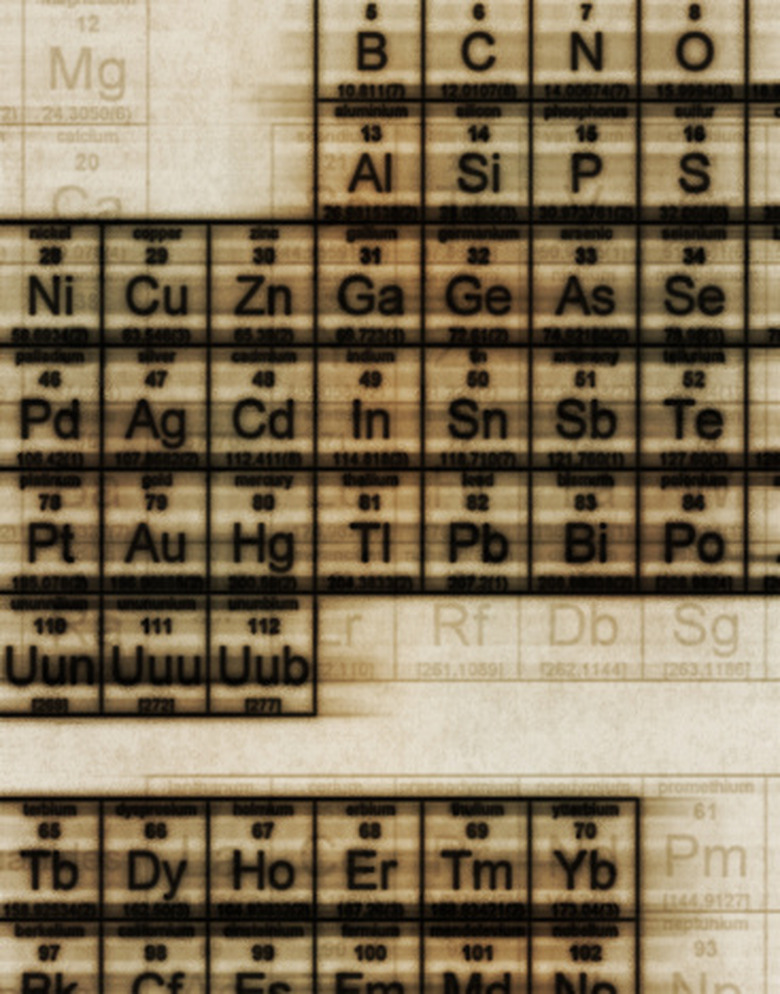How To Memorize Ionic Compounds
Reciting the names of ionic compounds may seem a daunting task. However, there are a few simple rules you can use in memorizing the most commonly encountered ionic compounds in chemistry. An ionic compound has two parts: a positively charged cation and a negatively charged anion. By following rules for naming each part, you will find the process simple and easy.
Naming Cations
Step 1
Determine if the cation has only one possible charge by looking at the periodic table. If so, the cation name is simply the name of the compound. For example: NaCl is sodium chloride and KOH is potassium hydroxide. The alkali metals most commonly encountered are sodium (Na), lithium (Li) and potassium (K). The most commonly encountered alkali earth metals are magnesium (Mg) and calcium (Ca). Other metals that have only one charge include aluminum (Al), zinc (Zn) and silver (Ag).
Step 2
Determine if the cation is a transition metal. Some metals require a change of name: Pb = plumb, Fe = ferr, Cu = cupr, Sn = stan. You can remember these names by referring to their symbols.
Step 3
Determine if the cation has two possible charges. If so, name cations with the lower charge with the suffix "-ous" and the higher charge with the suffix "-ic." For example, Cu+ is cuprous, Cu2+ is cupric. Fe2+ is ferrous, Fe3+ is ferric. Pb2+ is plumbus, Pb3+ is plumbic. Hg(2)2+ is mercurous, Hg2+ is mercuric. Sn2+ is stannous, Sn4+ is stannic.
Step 4
Determine if the cation is hydrogen. If so, it is simply named "hydrogen." For example, H2S is hydrogen sulfide.
Naming Anions
Step 1
Determine if the anion is a negatively charged single element. If so, then name it with the suffix -ide. For example: O = oxide, F = flouride, Cl = chloride, Br = bromide.
Step 2
Determine if the anion is a polyatomic anion with oxygen. If so, use the suffix "-ate" for compounds with more oxygen, and -ite in compounds with less oxygen. For example: SO4 = sulfate, SO3 = sulfite, NO3 = nitrate, NO2 = nitrite.
Step 3
Determine if the anion is -OH. If so, it is named hydroxide. For example: KOH is potassium hydroxide.
Step 4
Determine if the anion is hydrogen. If so, it is named "hydride." For example: LiH is lithium hydride.
TL;DR (Too Long; Didn't Read)
To name ionic compounds, you must first know the names and symbols of the most commonly encountered elements. If you are not familiar with them, obtain a periodic table and learn this information.
Cite This Article
MLA
Foulds, David. "How To Memorize Ionic Compounds" sciencing.com, https://www.sciencing.com/memorize-ionic-compounds-8274123/. 24 April 2017.
APA
Foulds, David. (2017, April 24). How To Memorize Ionic Compounds. sciencing.com. Retrieved from https://www.sciencing.com/memorize-ionic-compounds-8274123/
Chicago
Foulds, David. How To Memorize Ionic Compounds last modified March 24, 2022. https://www.sciencing.com/memorize-ionic-compounds-8274123/
